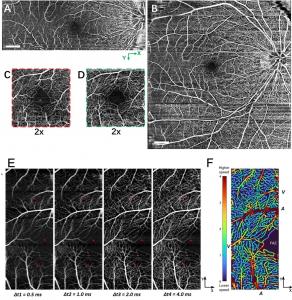Wide-Field, Quantitative OCT Angiography with Spectrally Extended Line Field Technology
A New Avenue for Early Diagnosis.
CHENGDU, SICHUAN, CHINA, June 18, 2025 /EINPresswire.com/ -- Check the full article here: https://www.oejournal.org/article/doi/10.29026/oea.2025.240293Optical coherence tomography angiography (OCTA) offers an opportunity for non-invasive detection of eye diseases, cardiovascular disorders, neurodegenerative conditions and even cancers. However, its widespread usage is hindered by its limited image acquisition speed and signal strength. These limitations create an unavoidable compromise between scanning area and image clarity. Most significantly, they block clinicians from obtaining quantitative data, such as blood flow velocity, a crucial early-warning signal of disease progression that often appears before any visible structural abnormalities emerge. Spectrally extended line field OCTA (SELF-OCTA) offers a cost-effective solution to these challenges. This imaging technology achieves a multiplicative increase in image acquisition speed via parallel sampling, while concurrently improving signal strength and enabling safter ocular laser application. SELF-OCTA demonstrates significant advantages over conventional OCTA technologies in both human skin and retina in vivo imaging: (1) achieving significantly enlarged field of view while preserving microvascular details, and (2) enabling blood flow velocity measurement across an unprecedented range (Fig. 1). The technology does not require significant alterations with respect to the OCTA devices commonly used in the clinics, emphasizing that the above-mentioned advanced imaging capabilities can be widely deployed and available for disease screening, early diagnosis and follow-up in large populations. One of such diseases is diabetic retinopathy (DR) which requires constant follow-ups with wide field over long term periods. However, there is few wide-field OCTA device accessible and affordable. SELF-OCTA will potentially make wide-field OCTA accessible and affordable to all DR patients with low-cost. One of the other such diseases is age-related macular degeneration (AMD) which can be diagnosis earlier by quantitatively examining the abnormal changes in blood flow velocity. SELF-OCTA will potentially change the screening and diagnostic paradigm of diseases by detecting the disease at the reversible or treatable stage, instead of advanced stages. SELF-OCTA also opens the avenue for screening systematic diseases noninvasively and conveniently with retinal OCTA at earlier stages, including but not limited to coronary atherosclerosis, strokes, Alzheimer’s disease, and dementia.
The research group of Prof. Linbo Liu from Guangzhou National Laboratory collaborates with Prof. Jia Qu from Oujiang laboratory, Prof Xiaokun Wang & Yukun Wang from Changchun Institute of Optics, Fine Mechanics and Physics, Chinese Academy of Science, Dr. Chen Hsin Sun from National University of Singapore, and Prof. Xin Ge from Sun Yat-sen University on and the team introduce a generation of OCT angiographic technology, termed spectrally extended line field OCTA (SELF-OCTA) to address the clinical pain points, including but not limited to the lack of a quantitative retinal blood velocimetry tool and the lack of a wide-field, widely accessible OCTA tool. The first-author, Dr. Si Chen, led the technology development and extend its application to the skin imaging and retinal diagnosis. SELF-OCTA breaks imaging speed and signal strength bottlenecks of the current OCTA technology, achieving at least three times larger imaging field of view and more than two times higher signal strength (Fig. 1). This advantage is important for early diagnosis and follow-up of diabetic retinopathy (DR) because in DR the lesion is more likely to scatter in the peripheral retinal region than the central, necessitating wide-field imaging. The current standard OCTA may miss peripheral lesions due to limited field of view. With more than three times larger field of view, SELF-OCTA will be the perfect solution for this urgent clinical need.
Equally importantly, owning to these fundamental breakthroughs, SELF-OCTA makes it possible for the first-time quantification of human retinal blood flow velocity in vivo down to capillary level over a clinically meaningful field of view and a wide velocity range (Fig. 1). This advance will benefit those with age-related macular degeneration patient, the top sight threatening disease with rising social-economic burden due to ageing. Current technology can only diagnose AMD by detecting new blood vessels or missing blood vessels, but at this stage the disease is largely irreversible and management is difficult. With the ability to detect minute changes in the blood velocity, it is expected that SELF-OCTA could differentiate AMD patients from normal ageing group at a stage well before structural change occurs such as new blood vessels or missing blood vessels, thereby making it possible to treat the disease at the reversible stage. In addition, since the vascular networks in the eye also reflects the progression of systematic diseases, moving forward the team will focus on predicting cardiovascular diseases and neurodegenerative diseases with SELF-OCTA data. Powered by low-cost SELF-OCTA hardware and AI algorithms, mass screening for these visions and life-threatening diseases will be possible.
Dr Liu received B.Eng in Precision Instrument in 2001, and M. Eng. in Optical Engineering in 2004, from Tianjin University, China. He received PhD in Graduate Programme in Bioengineering (GPBE) in 2008 from School of Medicine, National University of Singapore. From 2008-2011, he received his postdoctoral training in Wellman Center in Photomedicine, Harvard Medical School (HMS) and Massachusetts General Hospital (MGH) where he developed and established a new generation of OCT technology termed micro-Optical Coherence Tomography (µOCT). Dr Liu was promoted as an Instructor in Dermatology at HMS before he joined the School of Electrical and Electronic Engineering and School of Chemical and Biomedical Engineering at Nanyang Technological University in 2012-2024. Dr Liu is currently with Guangzhou National Laboratory. His research interests are mainly focused on development and validation of non-invasive, cellular and sub-cellular resolution imaging methods for disease diagnosis and life science research.
Andrew Smith
Charlesworth
+44 7753 374162
email us here
Visit us on social media:
LinkedIn
YouTube
Other
Legal Disclaimer:
EIN Presswire provides this news content "as is" without warranty of any kind. We do not accept any responsibility or liability for the accuracy, content, images, videos, licenses, completeness, legality, or reliability of the information contained in this article. If you have any complaints or copyright issues related to this article, kindly contact the author above.


